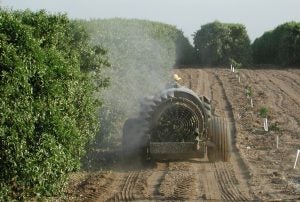A team of researchers has discovered that organic farming in one California county significantly affects the amount of pesticide used in neighboring fields — many organic fields together appear to reduce overall pesticide use, but an organic field in close proximity to conventional fields likely increases the region’s pesticide use.
Many people have been pushing to increase organic production in the U.S., and it’s long been unclear how this would affect pests and pest control on organic farms and their neighbors. The Organic Center, a research arm of the Organic Trade Association, has even noted that there is a research gap in organics compared with the extensive research done on conventional crops.
So, a team of researchers from the University of California Santa Barbara, the University of British Columbia, and the University of Colorado Boulder sought to understand these interactions between fields, which they call “spillover effects.” Their study was published in the journal Science.
Most pesticide studies have focused on the field level, one of the study authors said, comparing metrics like biodiversity, soil health, and pesticide use between organic and conventional fields. However, agricultural pests and their predators move beyond field boundaries.
“We find that organic cropland generally leads to a decrease in pesticide use on nearby organic fields,” said lead author Ashley Larsen, an ecologist at UCSB’s Bren School of Environmental Science & Management. “In contrast, organic agriculture leads to a small, but significant, increase in pesticide use on nearby conventional fields.” The authors suspect the different responses reflect different reliance on natural pest control methods, although they admit the mechanisms are difficult to test with their data.
Organic agriculture generally refers to the farming of crops or livestock without the use of most synthetic inputs, including synthetic fertilizers, pesticides, plant growth regulators, nanomaterials, and genetically engineered organisms. Organic does not necessitate “chemical-free” or “pesticide-free”; chemicals are often used in organic farming, however these cannot be synthetically manufactured, with the exception of a small number which have been approved by the National Organic Standards Board.
“Organic fields leverage the benefits of natural enemies that reduce the number of pests on their fields, like birds and bugs that eat smaller problematic pests,” said co-author Claire Powers, a former graduate student at Bren now pursuing her doctorate at CU Boulder. These predators and pests then venture into neighboring fields for shelter and food.

Organic farmers can benefit from a greater abundance or persistence of their pests’ natural enemies, which can be harmed by synthetic pesticides in conventional fields. Thus, the researchers said, organic farmers could benefit from clustering together. On the other hand, an influx of insects from organic fields could drive up the use of synthetic pesticides in conventional fields since these fields have smaller, less effective populations of those beneficial species.
The tradeoff between these two systems, however, includes yield. Globally, producers have achieved large gains in productivity and gains in yield over the past half-century in particular, largely as a result of the availability and intensification of inputs such as fertilizer and pesticides, according to statistics service Our World in Data. As a result, the majority of conventional systems achieve a significantly higher yield than organic systems. Therefore, to produce the same quantity of food, organic systems require a larger land area and greater resources in that way. The research team appeared to compare pesticide use on raw acreage and not scaled to fit a rate of food production output.
From a pesticide standpoint, Powers said, “The big takeaway from this research is to stack organic fields next to organic fields and conventional fields next to conventional fields.”
These conclusions are the culmination of an involved process. The authors faced major challenges even finding usable data.
“You have to be able to identify specific fields in a spatial data format, link that spatial data to each field’s pesticide-use rates, and also determine which fields are organic and which are conventional,” Powers explained. This information comes from several sources that can be tough to combine. What’s more, agricultural spatial data and pesticide use aren’t particularly well tracked, especially outside of California, the researchers claimed.
The team said they did find one region that kept detailed records and made them publicly available: Kern County, California. As far as the authors were concerned, it was the golden ticket of the Golden State.
“Kern County has annual spatial data for their agricultural fields that can be linked to the two other crucial datasets — pesticide use and organic-crop producer IDs — which is really rare,” Powers said.
The team paired digitized maps of fields and the crops grown on them with records of pesticide applications and whether a field had an organic certification.
However, the paper said toxicity information for all products in use in California is not readily available for any, let alone most, environmental endpoints and is particularly sparse for organic-approved products.


